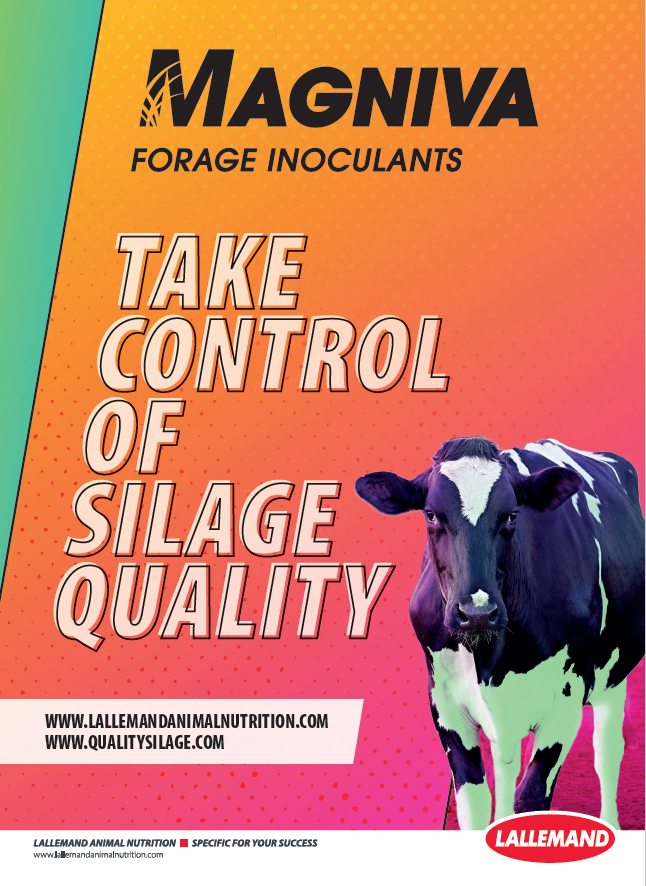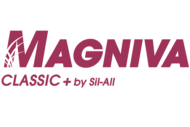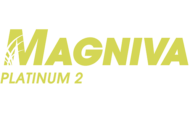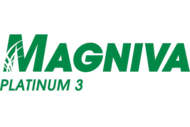MAGNIVA Forage Inoculant

Lowers pH quickly
Specific and unique strains of Lactobacillus bacteria found in MAGNIVA Silage Inoculants quickly and efficiently preserve the silage, by quickly increasing lactic acid levels and lowering the pH to a safe level. This maintains silage nutrient and energy levels and minimizes DM losses.

Improves aerobic stability
MAGNIVA Platinum Silage Inoculants improves the aerobic stability of the silage when opened, actively inhibiting undesirable yeast and mold growth, reducing heating, spoilage and significantly reducing dry matter losses.

Lessens energy losses during fermentation and feedout
Inhibiting development of undesirable microorganisms with MAGNIVA Silage Inoculants helps retain the full nutritional and energy values of your silage, meaning when fed to animals, the silage will be of optimal quality to drive performance.
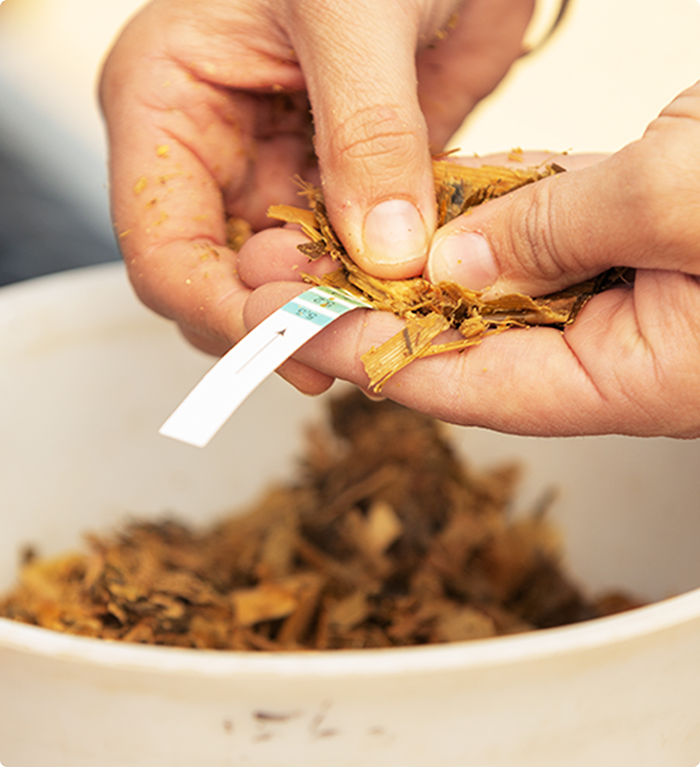
Managing feed costs is crucial to achieving on-farm profitability
Conversion of forage to silage produces a long term stable feed that gives the farmer the flexibility to produce more, while cutting the cost of production.

Lentilactobacillus hilgardii CNCM I-4785
We discovered a gamechanger strain of silage inoculant
What producers are saying about MAGNIVA
“In trials, wholecrop silage was ensiled with either no inoculant or with MAGNIVA Platinum. The MAGNIVA inoculant kept the silage much cooler for the whole period, meaning more energy would be available to feed.”
Name: Bury Barton Farm
Location: Lapford, UK
Size: 100 mainly Limousin suckler cows
Inoculant: MAGNIVA Platinum
Producing and utilising high-quality silage is central to success for a beef unit in mid-Devon. Andrew Quick and his son Edward farm 400 acres at Bury Barton Farm, Lapford, which is home to 100 mainly Limousin suckler cows split into spring and autumn calving groups and 500 ewes. Mainly down to grass, they also grow 60 acres of spring barley for wholecrop, 30 acres of forage maize and 70-80 acres of cereals. They finish all the suckler calves, which are weaned at 8 months and will finish at 16-18 months. They also buy in mainly British Blue and Limousin steers and a few heifers at around five months old. In total, they finish around 250 cattle per year. Home-bred animals and bought-in steers are targeted at a 370kg carcase, while bought-in heifers go at around 330kg carcass weight. Quality silage is at the heart of the system. The Quicks make fermented wholecrop cereals, maize and grass silage, which form the basis of growing and finishing rations that which typically comprise one third of each forage. First cut grass is taken in late May with a second cut in mid-June. Second cut is used for the suckler cows and is allowed to become more stemmy. “Silage is a big investment for us so we focus on making the best quality we can and also on reducing waste,” Andrew explains. “The more high-quality forage we can feed, the lower our overall costs. Silage waste just pushes up costs because all the investment in making silage is related to the feed we put in the clamps, not what we feed out. So, we do all we can to waste as little as possible.” Andrew targets making all forages at above 30% dry matter. Growing cattle are fed 17-18kg of mixed silages per day while the finishers will get 20kg/day. Both groups are also fed home grown wheat, but Andrew doesn’t feed any purchased protein as there is enough in the grass silage. “One of our priorities when making silages, particularly wholecrop and maize, is achieving good aerobic stability,” Andrew continues. “We feed out once a day, so we need the forages to keep cool and fresh to ensure we achieve high intakes. “We also need the clamps to stay cool in the summer when we are using less as we have more cattle out at grass, which means we go across the clamp slower. A face exposed for a long time in heat could lead to increased problems with heating, which reduces intakes and feed value as heat is just energy being burnt up.” To help minimise waste and aerobic spoilage, Andrew has been working with Steve Symons from Lallemand Animal Nutrition and in 2019 used MAGNIVA inoculants on the wholecrop and maize. “There are two key objectives when making silage, whatever the crop,” Mr Symons comments. “The first is to achieve a rapid initial fermentation and pH drop while the second is to keep the crop stable once it is opened. “Magniva Platinum crop and condition specific forage inoculants, which supersede the Biotal range, combine the proven strain L buchneri 40788 with the totally new patented bacterium L Hilgardii I-4785. They deliver the rapid initial fermentation and then quickly produce a number of antifungal compounds to knock back the yeasts and moulds responsible for heating, improving immediate aerobic stability, meaning clamps can be opened sooner. They also improve longer term aerobic stability, protecting the silage while the clamp is open. “In trials wholecrop silage was ensiled with either no inoculant or with Magniva Platinum Wholecrop. The Magniva inoculant kept the silage much cooler for the whole period, meaning more energy would be available to feed. “With margins continuing to be squeezed, focusing on maximising the use of high-quality forage will be crucial for beef producers,” he concludes.
Andrew Quick
Beef producer
“In trials, wholecrop silage was ensiled with either no inoculant or with MAGNIVA Platinum. The MAGNIVA inoculant kept the silage much cooler for the whole period, meaning more energy would be available to feed.”
Name: Bury Barton Farm
Location: Lapford, UK
Size: 100 mainly Limousin suckler cows
Inoculant: MAGNIVA Platinum
Producing and utilising high-quality silage is central to success for a beef unit in mid-Devon. Andrew Quick and his son Edward farm 400 acres at Bury Barton Farm, Lapford, which is home to 100 mainly Limousin suckler cows split into spring and autumn calving groups and 500 ewes. Mainly down to grass, they also grow 60 acres of spring barley for wholecrop, 30 acres of forage maize and 70-80 acres of cereals. They finish all the suckler calves, which are weaned at 8 months and will finish at 16-18 months. They also buy in mainly British Blue and Limousin steers and a few heifers at around five months old. In total, they finish around 250 cattle per year. Home-bred animals and bought-in steers are targeted at a 370kg carcase, while bought-in heifers go at around 330kg carcass weight. Quality silage is at the heart of the system. The Quicks make fermented wholecrop cereals, maize and grass silage, which form the basis of growing and finishing rations that which typically comprise one third of each forage. First cut grass is taken in late May with a second cut in mid-June. Second cut is used for the suckler cows and is allowed to become more stemmy. “Silage is a big investment for us so we focus on making the best quality we can and also on reducing waste,” Andrew explains. “The more high-quality forage we can feed, the lower our overall costs. Silage waste just pushes up costs because all the investment in making silage is related to the feed we put in the clamps, not what we feed out. So, we do all we can to waste as little as possible.” Andrew targets making all forages at above 30% dry matter. Growing cattle are fed 17-18kg of mixed silages per day while the finishers will get 20kg/day. Both groups are also fed home grown wheat, but Andrew doesn’t feed any purchased protein as there is enough in the grass silage. “One of our priorities when making silages, particularly wholecrop and maize, is achieving good aerobic stability,” Andrew continues. “We feed out once a day, so we need the forages to keep cool and fresh to ensure we achieve high intakes. “We also need the clamps to stay cool in the summer when we are using less as we have more cattle out at grass, which means we go across the clamp slower. A face exposed for a long time in heat could lead to increased problems with heating, which reduces intakes and feed value as heat is just energy being burnt up.” To help minimise waste and aerobic spoilage, Andrew has been working with Steve Symons from Lallemand Animal Nutrition and in 2019 used MAGNIVA inoculants on the wholecrop and maize. “There are two key objectives when making silage, whatever the crop,” Mr Symons comments. “The first is to achieve a rapid initial fermentation and pH drop while the second is to keep the crop stable once it is opened. “Magniva Platinum crop and condition specific forage inoculants, which supersede the Biotal range, combine the proven strain L buchneri 40788 with the totally new patented bacterium L Hilgardii I-4785. They deliver the rapid initial fermentation and then quickly produce a number of antifungal compounds to knock back the yeasts and moulds responsible for heating, improving immediate aerobic stability, meaning clamps can be opened sooner. They also improve longer term aerobic stability, protecting the silage while the clamp is open. “In trials wholecrop silage was ensiled with either no inoculant or with Magniva Platinum Wholecrop. The Magniva inoculant kept the silage much cooler for the whole period, meaning more energy would be available to feed. “With margins continuing to be squeezed, focusing on maximising the use of high-quality forage will be crucial for beef producers,” he concludes.
Andrew Quick
Beef producer
“The silage stayed very cool in the bag, and we had no issues with mold. It made me a believer.”
Name: Vander Groef Family
Location: Northern New Jersey, USA
Size: 100 Holstein cows
Inoculant: MAGNIVA Titanium
Jeff and Tracy Vander Groef milk about 100 Holstein cows in Northern New Jersey. Just an hour from New York City, the farm is a true family operation. Two of their sons joined the operation full time and a third is working part time while finishing high school. To help control costs, the family focuses on keeping feed expenses down by feeding mostly forages they produce themselves. In good growing years, the Vander Groef family can sell extra forages. “We grow more than we need in a good year,” Jeff Vander Groef said. “This year was one of those tougher years. We had a very serious drought. We had to chop half our grain corn for silage in order to have enough silage. Thus, forcing us to have to buy enough other corn to make enough high moisture corn (HMC) to feed.” In addition to HMC, he grows alfalfa and grass for haylage. Haylage isn’t an easily fermentable crop, which led Vander Groef to change his approach to ensiling and focus on management to help maintain quality. He switched to trench silos, always uses a forage inoculant and covers with a weather- and oxygen-barrier to prevent spoilage and minimize losses. This focus on reducing waste helps the family ensure better quality haylage at feed out and retain as much quantity as possible to help reduce purchased feed costs. The Vander Groef family also runs a King’s AgriSeeds dealership, which helps in sourcing corn varieties. He selects seeds that have good digestible fiber when planting, and then focuses on ensiling management to minimize dry matter (DM) losses. Microbial inoculation for protection In previous years, the farm applied propionic acid to HMC at ensiling. The HMC continued to heat during the summer, and the Vander Groefs battled mold issues. Searching for solutions, he tried MAGNIVA Forage Inoculants from Lallemand Animal Nutrition three years ago and treated one bag as a test. “We had excellent results,” Vander Groef said. “The silage stayed very cool in the bag, and we had no issues with mold. It made me a believer. This year, we chopped a lot of drought-stressed corn and treated everything. We wanted to eliminate possible issues with forage that wasn’t top quality to begin with.” He applied MAGNVIA Titanium to all 2022 forages. The inoculant contains Lactobacillus buchneri NCIMB 40788 and high-activity enzymes. The high-dose rate L. buchneri NCIMB 40788 is the only silage inoculant reviewed by the FDA to allow claims for improved aerobic stability. The farm milks twice a day and feeds once a day, making bunk stability important. “With stable forages, we don’t get heating in the feed bunk — especially in the summer months,” Vander Groef explained. “That feed is in front of the cows until the next afternoon, so you want to make sure the forage is good and stable. In the summertime, the bunk can heat up. Then you lose intakes. Stable forage that is still cool 22 to 24 hours after it’s put in the bunk is the other piece of the puzzle that’s worth the investment.” The past year, Vander Groef noted his herd’s overall reproductive efficiency improved. “There are so many things that can factor into that, but I’m happy to eliminate mold issues in the feed as one potential cause,” he said. “Inoculant isn’t cheap, but it’s worth it. With recent growing conditions, we haven’t had the best forages going in. We have to protect whatever quality we have.”
Vander Groef
Dairy producer
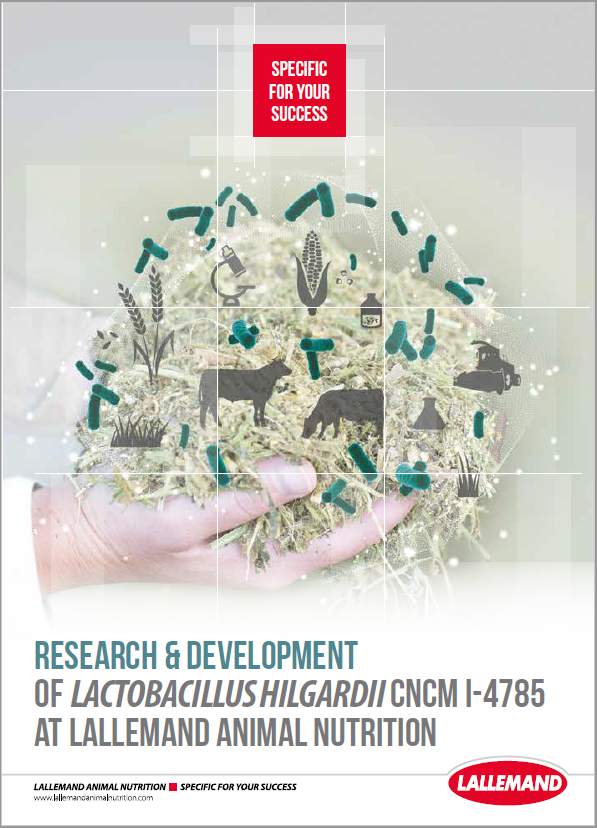
L.hilgardii R&D brochure
